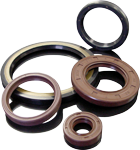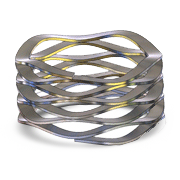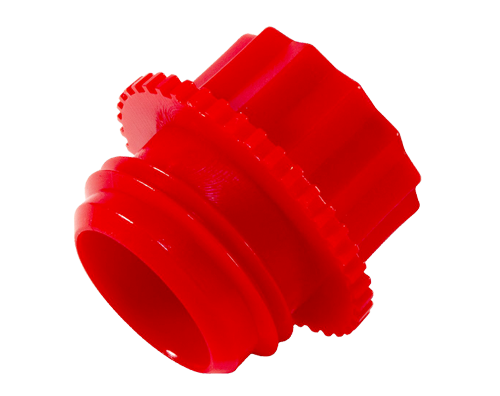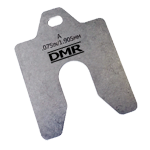Home >> Slide >> Fiber-Lube Bushings >> CJ/FCJ Fiber-Lube Lubrication
Fiber-Lube Lubrication
Daemar’s Fiber Lube composite bushings allow true self lubrication. Ideal for long-term highly loaded applications. Additional benefits include: low friction values and resistance to corrosion.
Lubrication
The synthetic fiber/PTFE fabric wear surface of the CJ bearing is a self-contained boundary lubrication system; however, the addition of conventional lubricants often improves the overall performance of the CJ bearing. “Lubricant” is a very general term, and it is often said that any liquid will act as a lubricant. To some extent, this is true if hydrodynamic conditions are established, and the surfaces have minimal contact. The composite bearing, in earth moving equipment, operates generally in a state of boundary lubrication. Hydrocarbon oils are advantageous and can produce tenfold reductions in wear rates. Liquid lubricants can carry away heat and reduce the coefficient of friction. Greases can be used for lubrication, to prevent corrosion, and keep contamination out of the journal. In oscillating motion, the synthetic fiber/PTFE liner acts as a true boundary lubricant when the direction of motion changes and the lubrication film collapses. In rotation, with oil lubrication, the wear rate of the CJ composite has been found equal to sintered or cast bronze bearings. Fluorocarbon oils and greases should be avoided because they have been found to soften the synthetic fibers and greatly increase the rate of wear. It is possible to add lubrication holes to the CJ bearing, but grooves are impractical. The abrasion resistance of the synthetic fibers makes groove fabrication difficult and costly.
The synthetic fiber/PTFE fabric wear surface of the CJ bearing is a self-contained boundary lubrication system; however, the addition of conventional lubricants often improves the overall performance of the CJ bearing. “Lubricant” is a very general term, and it is often said that any liquid will act as a lubricant. To some extent, this is true if hydrodynamic conditions are established, and the surfaces have minimal contact. The composite bearing, in earth moving equipment, operates generally in a state of boundary lubrication. Hydrocarbon oils are advantageous and can produce tenfold reductions in wear rates. Liquid lubricants can carry away heat and reduce the coefficient of friction. Greases can be used for lubrication, to prevent corrosion, and keep contamination out of the journal. In oscillating motion, the synthetic fiber/PTFE liner acts as a true boundary lubricant when the direction of motion changes and the lubrication film collapses. In rotation, with oil lubrication, the wear rate of the CJ composite has been found equal to sintered or cast bronze bearings. Fluorocarbon oils and greases should be avoided because they have been found to soften the synthetic fibers and greatly increase the rate of wear. It is possible to add lubrication holes to the CJ bearing, but grooves are impractical. The abrasion resistance of the synthetic fibers makes groove fabrication difficult and costly.
Thermal Properties
The operating temperature range for CJ bearings is -320°F to +300°F (-195°C to +149°C). The bearing has been heat stabilized at a temperature above 300°F (149°C) and very little dimensional change will occur in the bearing during operation. In the free state, the coefficient of expansion of the CJ bearing in the radial direction is approximately 7 x 10-6 in/in/°F. When press fit into a housing, the CJ bearing assumes the coefficient of expansion of the housing material, as long as the press fit is maintained, and thus the elastic modulus of the bearing is maintained, because the elastic modulus of the bearing is lower than the elastic modulus of most metals.
The CJ composite is a thermal insulator and when heat is generated from running friction, the bearing wear surface may be hotter than the adjacent housing due to the thermal lag.
Since the installed bearing cannot expand outward, it grows inward, reducing the shaft clearance. For this reason, the shaft clearance should be increased for dry running applications that have high running velocities. Naturally, fluid cooling and lubricants will reduce the operating temperatures. Heat transfer through the bearing wall is proportional to the wall thickness, and the thinner the composite wall, the greater the transfer of heat.
The operating temperature range for CJ bearings is -320°F to +300°F (-195°C to +149°C). The bearing has been heat stabilized at a temperature above 300°F (149°C) and very little dimensional change will occur in the bearing during operation. In the free state, the coefficient of expansion of the CJ bearing in the radial direction is approximately 7 x 10-6 in/in/°F. When press fit into a housing, the CJ bearing assumes the coefficient of expansion of the housing material, as long as the press fit is maintained, and thus the elastic modulus of the bearing is maintained, because the elastic modulus of the bearing is lower than the elastic modulus of most metals.
The CJ composite is a thermal insulator and when heat is generated from running friction, the bearing wear surface may be hotter than the adjacent housing due to the thermal lag.
Since the installed bearing cannot expand outward, it grows inward, reducing the shaft clearance. For this reason, the shaft clearance should be increased for dry running applications that have high running velocities. Naturally, fluid cooling and lubricants will reduce the operating temperatures. Heat transfer through the bearing wall is proportional to the wall thickness, and the thinner the composite wall, the greater the transfer of heat.






